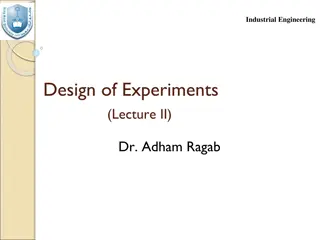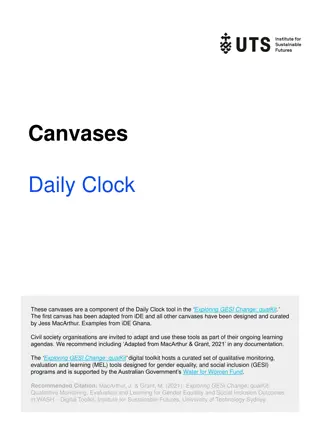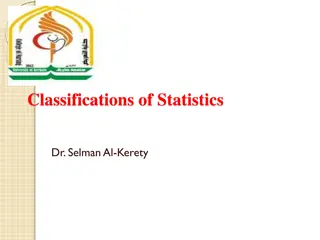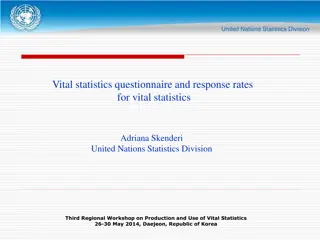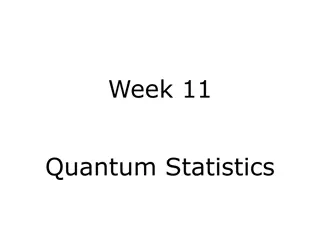Exploring the History and Applications of Statistics in Daily Life
The study of statistics, derived from Latin and Italian roots, dates back centuries to aid rulers in governance and decision-making. With advancements in the 20th century and the availability of technology, statistics now plays a crucial role in various sectors like education, business, and sports, providing valuable insights for informed decision-making. From defining statistics to analyzing data for performance boost and enhancing customer experience, its relevance in daily life is evident.
Download Presentation

Please find below an Image/Link to download the presentation.
The content on the website is provided AS IS for your information and personal use only. It may not be sold, licensed, or shared on other websites without obtaining consent from the author. Download presentation by click this link. If you encounter any issues during the download, it is possible that the publisher has removed the file from their server.
E N D
Presentation Transcript
SUBJECT- MATHEMATICS STD-IX WORK IS WORSHIP
E-BOOK NCERT TEXT BOOK (MATHEMATICS) NCERT EXAMPLER (MATHEMATICS) WORK IS WORSHIP
LEARNING OBJECTIVES The students will be able to define the word statistics differentiate statistic and statistics. classify different types of data, as primary and secondary. organize the data in the form of ungrouped and grouped frequency distribution. establish the data graphically ( such as Bar Graph, Histogram, Frequency Polygon). justify the Measures of Central Tendency of Ungrouped Data (Mean, Median and Mode) WORK IS WORSHIP
HISTORY OF STATISTICS The Word statistics has been derived from the Latin word Status or the Italian word Statista , means PoliticalState or aGovernment . Shakespeare used a word Statist is his drama Hamlet (1602). In the past, the statistics was used by rulers. The application of statistics was very limited but rulers and kings needed information about lands, agriculture, commerce, population of their states to assess their military potential, their wealth, taxation and other aspects of government. Gottfried Achenwall used the word statistic at a German University in 1749 which means that political science of different countries. In 1771 W. Hooper (Englishman) used the word statistics in his translation of Elements of Universal Erudition written by Baron B.F Bieford, in his book statistics has been defined as the science that teaches us what is the political arrangement of all the modern states of the known world. There is a big gap between the old statistics and the modern statistics, but old statistics are also used as a part of the present statistics. WORK IS WORSHIP
During the 18th century the English writers used the word statistics in their works, so statistics has developed gradually during last few centuries. A lot of work had been done in the end of the nineteenth century. At the beginning of the 20th century, William S Gosset had developed the methods for decision making based on small set of data. During the 20th century several statisticians are active in developing new methods, theories and application of statistics. Now these days the availability of electronics computers is certainly a major factor in the modern development of statistics. WORK IS WORSHIP
STATISTICS IN DAILY LIFE Effective collection and mining of statistical data can yield valuable insight for companies about the likes, dislikes and buying habits of their customers. CUSTOMER DATA Statistics not only help measure business performance , but can also provide a means for boosting it . Some firms even use data and statistics to experiment with ways to improve management decisions , final reports. PERFORMANCE BOOST Money spends on girls education comparison to boys education. Comparison of result of last 10 years. Number of new diseases grown in last 10 years. Increase in number of patients in different states in COVID-19 EDUCATION SPORTS Used to compare the run rates of different teams. etc WORK IS WORSHIP
STATISTICS IN DAILY LIFE Etc . WORK IS WORSHIP
INTRODUCTION https://www.youtube.com/ watch?v=SFPGVTThJNk WORK IS WORSHIP
INTRODUCTION Whenever we go through the newspaper, magazines, television and other means of communication, we come across a lot of information in the form of facts , figure , numerical tables, different types of graphs etc. These information may be related to with cricket batting or bowling average, loss or profit of a company polling result etc. The facts or figures ( that is numerical or otherwise), which we collect for a certain purpose are called DATA ( a plural form of Latin word datum ) We are living in the world which is more and more information oriented. That s why it becomes great necessity of us to know how to get meaningful information from such data. The method of extraction of such meaningful information , studied in a branch of mathematics is called STATISTICS WORK IS WORSHIP
INTRODUCTION A statistic (singular) or sample statistic is a single measure attribute of sample. STATISTIC Statistics is a whole mathematical science concerned with data collection , presentation, analysis and interpretation. Statistics is the calculation of Statistic. STATISTICS WORK IS WORSHIP
CONCEPT-I COLLECTION OF DATA Primary Data: Data collected for a definite purpose or by a group of investigators directly, is called primary data. Example: Five students of a school collect data about the height of fifty plants in the school which were planted in the previous month. Secondary Data: Data collected from a source which already had the information store, the data thus obtained is called secondary data.. Example: Census department of the Government of India has stored various kinds of information about the citizens of the country and we can have data for a definite purpose from this stored information. WORK IS WORSHIP
CONCEPT-II PRSENTATION OF DATA 1. Raw Data: An information of facts and figures collected for a definite purpose in any manner is termed as raw data . Example: Data collected about the heights of 11 cricket players of a school is given below: 152cm,154cm,152cm,153cm,157cm,153cm,152cm,159cm,155cm,154cm,157cm All the entries in the data are called values of the variables. The greatest observation of this data is 159cm The least observation of this data is 152cm So, ????? = ??????? ?????????? ????? ??????????? = 159 152 = 2?? WORK IS WORSHIP
CONCEPT-II PRSENTATION OF DATA 2. Data presented in ascending or descending order: Raw data can be arranged in ascending or descending order. Example: Data collected about the heights of 11 cricket players of a school is given below: 152cm,154cm,152cm,153cm,157cm,153cm,152cm,159cm,155cm,154cm,157cm The data in ascending order 152cm,152cm,152cm,153cm,153cm,154cm,154cm,155cm,157cm,157cm,159cm The data in descending order 159cm,157cm,157cm,155cm,154cm,154cm,153cm,153cm,152cm,152cm,152cm In each case , we find it convenient to mark the greatest and the least values of the data. WORK IS WORSHIP
CONCEPT-II The distinct figures in the above raw data are 35,40,45,50,60,65,75,80,85,90,95 PRSENTATION OF DATA Marks obtained Tally marks Frequency(f) 3. Data presented in the form of ungrouped frequency distribution: The number of times , a particular entry occur in the above raw data , is called the frequency of the entry. To determine the frequency of each distinct entry of the data, we draw tally marks in the form of small vertical lines , called bars. Example: Data collected about marks score by 40 student of STD-IX in Mathematics Examination out of 100 are 35,40,50,35,65,95,35,60,90,95,95,50,95,50,80,95,65,50,60, 35,40,35,95,90,85,75,60,65,75,90,95,85,35,60,50,60, 45,65,80,85 |||| | 6 35 || 2 40 | 1 45 |||| 5 50 |||| 5 60 |||| 4 65 || 2 75 || 2 80 ||I 3 85 ||| 3 90 |||| || 7 95 Total ? = ?? WORK IS WORSHIP
CONCEPT-II PRSENTATION OF DATA 4. Data presented in the form of grouped frequency distribution: When the data has a large number of values(entries) as ?1,?2,?3, .?? and most of them are distnict , it is more convenient to present this data into a finite number of groupings rather than presenting them separately. These groupings are called classes of the data. The number of entries of the data having their values lying in a class is defined as the frequency of that class. The table in which the corresponding frequencies are written against each class , is called a frequency distribution table of the given data. There are two types of grouped frequency distribution of data. These are (I) Inclusive method or discontinuous form of grouped frequency distribution of data (II) Exclusive method or continuous form of grouped frequency distribution of data WORK IS WORSHIP
CONCEPT-II PRSENTATION OF DATA Classes Tally marks Frequency(f) 4.(I) Data presented in the form of Inclusive(discontinuous) grouped frequency distribution (In each class we count the entries which have values greater than or equal to the lower limit and less than equal to the upper limit ) Example: Data collected about marks score by 40 student of STD-IX in Mathematics Examination out of 100 are 76,78,52,69,98,78,79,99,98,14,26,35,26,52,24,47,58, 67,35,46,29,33,53,62,19,8,25,69,57,58,49,36,25, 59,99,87,96,84,92,63 | 0-9 1 || 10-19 2 |||| | 20-29 6 |||| 30-39 4 40-49 3 ||| |||| || 50-59 7 |||| 60-69 5 |||| 70-79 4 || 80-89 2 |||| | 90-99 6 Total ? = ?? WORK IS WORSHIP
CONCEPT-II PRSENTATION OF DATA 4.(II) Data presented in the form of Exclusive(Continuous) grouped frequency distribution (In each class we count the entries which have values greater than or equal to the lower limit and less than the upper limit ) Example: Data collected about marks score by 40 student of STD-IX in Mathematics Examination out of 100 are 76,78,52,69,98,78,79,99,98,14,26,35,26,52,24,47,58, 67,35,46,29,33,53,62,19,8,25,69,57,58,49,36,25, 59,99,87,96,84,92,63 Classes Tally marks Frequency(f) | 1 0-10 || 10-20 2 |||| | 20-30 6 |||| 30-40 4 40-50 3 ||| |||| || 50-60 7 |||| 60-70 5 |||| 70-80 4 || 80-90 2 |||| | 90-100 6 Total ? = ?? WORK IS WORSHIP
CONCEPT-II PRSENTATION OF DATA 4.(III) Conversion of discontinuous grouped frequency distribution to continuous grouped frequency distribution. If we have a discontinuous grouped frequency distribution table in which the space in between the two consecutive classes is uniformly equal to the value 2h (Let), then by adding h to the upper limits of each class and subtracting h from the lower limits of each class , we get a continuous grouped frequency distribution. Example: 2 = 10 9 = 1 & = 0.5 Classes Frequency (f) Classes Frequency (f) 0.5-9.5 1 1 0-10 9.5-19.5 2 10-20 2 19.5-29.5 6 20-30 6 29.5-39.5 4 30-40 4 39.5-49.5 3 40-50 3 49.5-59.5 7 50-60 7 59.5-69.5 5 60-70 5 69.5-79.5 4 70-80 4 79.5-89.5 2 80-90 2 89.5-99.5 6 90-100 6 Total Total ? = ?? ? = ?? WORK IS WORSHIP
CONCEPT-II PRSENTATION OF DATA 4.(IV) Class mark of a class In a grouped frequency distribution , the class mark of a class ? ? is given by ?+? Example: The class mark of the class 10 20 is 10+20 4.(V) Class size of a class In a continuous (Exclusive) grouped frequency distribution , the class size of a class ? ? is given by ? ? Example: The class mark of the class 10 20 is 20 10 = 10 In a discontinuous (Inclusive) grouped frequency distribution , the class size of a class ? ? is given by ? ? + 1 Example: The class mark of the class 10 19 is 19 10 + 1 = 9 + 1 = 10 2 = 15 2 WORK IS WORSHIP
CONCEPT-III GRAPHICAL REPRSENTATION OF DATA A frequency distribution table presents raw data in a condensed form which is not easy to understand for every person , yet it is easy to understand more clearly than raw data. The main features of a frequency distribution can be easily presented with the help of graphical representations such as (I) Bar Graphs (II) Histograms (III) Frequency Polygons WORK IS WORSHIP
CONCEPT-III(A) BAR GRAPH OF DATA A Bar graph is a pictorial representation of the numerical data by a series of bars( rectangles) of uniform width, standing on the same horizontal ( or vertical) base line with equal spacing between the bars. The number of rectangles will be exactly the same as the number of values in the numerical data. The height of each bar is proportional to the numerical values of the data. It represents the numerical values of the data on a scale, selected suitably. WORK IS WORSHIP
CONCEPT-III(A) BAR GRAPH OF DATA Example: Given data is about the house hold expenditure of a family in the following table. 6 Heads Expenditure (in thousand rupees) 5 2 3 2 4 5 4 Thousand rupees) Expenditure ( In Rent Grocery Education Transport Miscellaneous 3 2 1 0 Rent Grocery Education Transport Miscellaneous Heads WORK IS WORSHIP
CONCEPT-III(B) HISTOGRAM FOR A CONTINUOUS GROUPED FREQUENCY DISTRIBUTION For a continuous frequency distribution , a series of rectangles are constructed having their widths equal to the widths of the classes and heights ( or lengths ) are selected in such a way that the areas of the rectangles are respectively proportional to the frequencies of the classes. In case the widths of the classes are uniform throughout , then the heights of the rectangles are proportional to the corresponding frequencies of the classes. By selecting suitable scales on x-axis and y-axis , the rectangles are drawn leaving no gap between the consecutive rectangles. The figure drawn , appears like a single solid figure is called Histogram. WORK IS WORSHIP
CONCEPT-III(B) HISTOGRAM FOR A CONTINUOUS GROUPED FREQUENCY DISTRIBUTION (widths are uniform) Example Classes 10-20 20-30 30-40 40-50 50-60 Total ( ?) Frequency(f) 4 6 2 5 3 20 Frequencies Classes WORK IS WORSHIP
CONCEPT-III(B) HISTOGRAM FOR A CONTINUOUS GROUPED FREQUENCY DISTRIBUTION (widths are not uniform) Height of rectangle corresponding to a class =????????? ?? ??? ????? ?????? ????? ???? ????? ?? ??? ????? Classes Frequency(f) Height of rectangle 10-20 5 ? ?? ?? = ? ? ?? ?? = ? ?? ?? ?? = ? ? ?? ?? = ? ? ?? ?? = ? 20-40 8 40-70 12 70-80 1 80-100 4 Total ( ?) 40 WORK IS WORSHIP
CONCEPT-III(B) HISTOGRAM FOR A DISCONTINUOUS GROUPED FREQUENCY DISTRIBUTION First , the given discrete form of grouped frequency distribution is converted into continuous form and then, a histogram is drawn for the new grouped frequency distribution(continuous form). Classes 2.5-6.5 6.5-10.5 10.5-14.5 14.5-18.5 18.5-22.5 Total ( ?) Frequency(f) 4 3 5 6 7 25 Classes 3-6 7-10 11-14 15-18 19-22 Total ( ?) Frequency(f) 4 3 5 6 7 25 DISCONTINUOUS FORM CONTINUOUS FORM WORK IS WORSHIP
CONCEPT-III(B) HISTOGRAM FOR A DISCONTINUOUS GROUPED FREQUENCY DISTRIBUTION First ,the given discrete form of grouped frequency distribution is converted into continuous form and then, a histogram is drawn for the new grouped frequency distribution(continuous form). Classes 2.5-6.5 6.5-10.5 10.5-14.5 14.5-18.5 18.5-22.5 Total ( ?) Frequency(f) 4 3 5 6 7 25 CONTINUOUS FORM WORK IS WORSHIP
CONCEPT-III(C) FREQUENCY POLYGON WITH THE HELP OF THE GIVEN FREQUENCY DISTRIBUTION METHODS STEP-I: Obtain the histogram for the given continuous frequency distribution . STEP-II: Assume that there are two classes of the same width with zero frequencies , one adjacent to the first on its left on the x-axis and the second adjacent to the last , on its right on the x-axis. STEP-III: Mark the mid-points of the assumed classes and the mid-points of the upper horizontal sides of each rectangle . STEP-IV: Complete the polygon by joining the mid- points by the line segments WORK IS WORSHIP
CONCEPT-III(C) FREQUENCY POLYGON BY USING CLASS MARKS OF THE CLASSES Classes Frequencies 4-6 6-8 8-10 10-12 12-14 3 2 4 3 4 STEP-I: First we will calculate the class marks of given class intervals. STEP-II: We have to take assumed class(2-4) on the left of the class (4-6) and another assumed class (14-16) on the right of the class (12-14).We will take the frequencies of these assumed classes to be zero. STEP-III: Now the class marks of all the classes are 3,5,7,9,11,13,15 and the corresponding frequencies of the classes are 0,3,2,4,3,4 and 0 respectively. 4.5 4 4 4 3 3 3.5 3 2 2.5 2 Frequencies 1.5 1 0 0 0.5 0 3 5 7 9 11 13 15 Classes WORK IS WORSHIP
CONCEPT-III(C) FREQUENCY POLYGON BY USING CLASS MARKS OF THE CLASSES Classes Frequencies 4-6 6-8 8-10 10-12 12-14 3 2 4 3 4 4.5 4 4 4 3 3 STEP-IV: Plot the points 3,0 , 5,3 , 7,2 , 9,4 , 11,3 , 13,4 ??? ( 15,0) by taking the x-coordinates of the points equal to the class marks of the classes and the y-coordinates as the frequencies of the corresponding classes. STEP-V: Join the points , then we will get a closed figure with x-axis. It is the frequency polygon of the given frequency distribution table. 3.5 3 2 2.5 2 Frequencies 1.5 1 0 0 0.5 0 3 5 7 9 11 13 15 Classes WORK IS WORSHIP
What is Central Tendency? Earlier in this chapter we have represented the data in various forms through frequency distribution tables , bar graphs, histograms and frequency polygons. Now the question arises , do we always need to study all the data to make sense of it or can we make out some important observations from it by considering only certain representatives of the data ? This is possible by measuring Measures of Central Tendency. WORK IS WORSHIP
What is Central Tendency? Central tendency is a descriptive summary of a dataset through a single value that reflects the center of the data distribution. Along with the variability (dispersion) of a dataset, central tendency is a branch of descriptive statistics. The central tendency is one of the most quintessential concepts in statistics. Although it does not provide information regarding the individual values in the dataset, it delivers a comprehensive summary of the whole dataset. WORK IS WORSHIP
What is Central Tendency? Measures of Central Tendency Generally, the central tendency of a dataset can be described using the following measures: Mean (Average): Represents the sum of all values in a dataset divided by the total number of the values. Median: The middle value in a dataset that is arranged in ascending order (from the smallest value to the largest value). If a dataset contains an even number of values, the median of the dataset is the mean of the two middle values. Mode: Defines the most frequently occurring value in a dataset. In some cases, a dataset may contain multiple modes while some datasets may not have any mode at all. WORK IS WORSHIP
The Mean, Median and Mode Toads https://www.youtube.com /watch?v=5C9LBF3b65s WORK IS WORSHIP
MEAN If we have n observations in a data with values ?1,?2,?3, ..?? then the mean or average of data is given by ? =?1+?2+?3+ +?? ? 1 ? ?=1 ? We can also write ? = ?? ? ? Or, ?=1 ??= ? ? , ?=1 ??= ?1+ ?2+ ?3+ + ?4 WORK IS WORSHIP
MEAN EXAMPLE: The mean of 12 values of a data is calculated as 19.25. If one more value is included in the data, then for 13 values of the new data , the mean becomes 20. Find the value of this 13th observation. [3] Ans: Let ?1,?2,?3, ..?12are the 12 values of the data and 13th value is ?13 ATQ, ?1+?2+?3+ +?12 12 = 19.25[1] ?1+ ?2+ ?3+ + ?12= 231 ? Now, ?1+?1+?3+ +?12+?13 13 = 20 ?1+ ?2+ ?3+ + ?12+ ?13= 260 231 + ?13= 260[1] ?13= 260 231 ?13= 29 So the 13th observation is 29 [1] WORK IS WORSHIP
MEAN FOR UNGROUPED FREQUENCY DISTRIBUTION Values: ?1,?2,?3, ..?? Frequencies : ?1,?2,?3, ?? The number of observations in the data= ?1+ ?2+ ?3+ + ??= ?=1 The sum of the values of all the observations in the data = ?1 ?1+ ?2 ?2+ + ?? ??= ?=1 The mean or the average of the data is given by ? =?1 ?1+?2 ?2+?3 ?3+ +?? ?? ?1+?2+?3+ +?? ? = ?=? ?? ? ?? ? ?? ?? ? ?=1 ?? ?? ? WORK IS WORSHIP
MEAN EXAMPLE: Find the mean ?? ?? 3 4 7 10 11 [3] 7 5 9 5 6 Ans: ?? ?? ???? 3 7 21 For Table-[1 ] 4 5 20 7 9 63 10 5 50 We know that Mean, ? = ???? ?? =220 32= 6.875 11 6 66 [1 ] ??= 32 ????= 220 WORK IS WORSHIP
MEDIAN Median of data is the middle most value when the data is arranged in ascending or descending order of magnitude. If number of observations= ? Median =?+1 2? ???????????(? ???) Median =1 2{? ? 2+ 1 ? ???????????}(? ????) 2? ??????????? + WORK IS WORSHIP
MEDIAN EXAMPLE: Calculate the median; 10,8,14,15,21,11,9,15,24 [2] Ans: Observations in ascending order = 8,9,10,11,14,15,15,21,24 [1/2] Number of observations,? = 9 (???) [1/2] So Median =?+1 2? ??????????? =10 2? ??????????? = 5? ??????????? = 14 [1] EXAMPLE: Calculate the median; 10,8,14,15,21,11,9,15,24,28 [2] Ans: Observations in ascending order = 8,9,10,11,14,15,15,21,24,28 [1/2] Number of observations,? = 10 (????) [1/2] So Median =1 2 =1 ? 2? ??????????? + 25? ??????????? + 6? ??????????? =1 ? 2+ 1 ? ??????????? 214 + 15 = 14.5 [1] WORK IS WORSHIP
MODE The value of an observation which occurs most frequently in the given data i.e. maximum number of times is called the mode of the data. EXAMPLE: Calculate the mode ; 10,8,14,15,21,10,8,10,24,10,25,10,11,11,9,15,24 Ans: Here the observation or the value 10 has maximum frequency Therefore, Mode=10 WORK IS WORSHIP
? ? Example: The mean of ?1,?2,?3, .?? ?? ?.If ?=1 then find the value of M and n ?? 8 = 24 , ?? 5 = 60 ??? ?=1 Answer: The mean of ?1,?2,?3, .?? ?? ? ?1+ ?2+ ?3+ + ?? ? (?1+?2+ ?3+ + ??) 8? = 24 ?? 8? = 24 (Equation 1) = ? By subtracting Equation(i) and Equation(ii) ?1+ ?2+ ?3+ + ??= ?? ?? 5? ?? 8? = 60 24 ? ATQ, ?=1 ?? 5 = 60 ?? 5? ?? + 8? = 36 ?1 5 + ?2 5 + + ?? 5 = 60 3? = 36 ?? ? = 12 (?1+?2+ ?3+ + ??) 5? = 60 By putting the value of n in Equation (1) ?? 5? = 60 (Equation 1) ? 12 5 12 = 60 ? ATQ, ?=1 ?? 8 = 24 12? = 120 ?? ? = 10 ?1 8 + ?2 8 + + ?? 8 = 24 ? = 10 & ? = 12 WORK IS WORSHIP
ACTIVITIES WORK IS WORSHIP
Average(Mean) Background: The Pythagoreans examined the arithmetic mean ?+? 2, the geometric mean, and the harmonic mean; and the relationships among them. The mean is the sum of all the numbers divided by the number of the items in the set. This is the value often intended when the word (s) average(s) is used. Piaget(s) research indicates that students cannot comprehend the concept of the mean until about age 12, when they become conservers and can consider two or more interrelated values simultaneously. Purpose: To introduce and develop the concept of finding an average (mean). Materials: Strips of construction paper, approximately 3 cm wide and longer than anyone(s) foot; tape; scissors; meterstick. Procedure 1: A.Distribute paper strips to each student. B.Announce to the class: Let(s) find the average foot length in our class. C.Cut your paper strip so that it(s) the same length as your foot. D.Now let(s)s tape all of our strips together. 1.Questions to Ask and Answer: How can we find the average foot size? 2.What is the length of your biggest long strip ? 3.How many feet do we have? 4.What is the length of the average foot ? A.Procedure 2: Cut the long strip into equal parts that stand for the average foot size in the class. B.Give one cut strip to each student. 5.Questions to Ask and Answer: Who has a foot that is about the size of the average foot? 6.Is your foot shorter or longer than average? 7.Suppose we all bought a pair of shoes in the average foot size, what would happen? Conclusion: (Total length of paper strip)/(number of strips) = Average foot size WORK IS WORSHIP
ART INTEGRATIONS WORK IS WORSHIP
RELATIONSHIP BETWEEN MEAN , MEDIAN AND MODE ???? = 3 ?????? 2 ???? ?????? =????+2 ???? ???? =3 ?????? ???? 2 3 WORK IS WORSHIP
NOTES Data: A systematic record of facts or different values of a quantity is called data. Data is of two types - Primary data and Secondary data. Primary Data: The data collected by a researcher with a specific purpose in mind is called primary data. Secondary Data: The data gathered from a source where it already exists is called secondary data Features of the data Statistics deals with collection, presentation, analysis and interpretation of numerical data. Arranging data in an order to study their salient features is called presentation of data. Data arranged in ascending or descending order is called arrayed data or an array Range of the data is the difference between the maximum and the minimum values of the observations WORK IS WORSHIP
NOTES Table that shows the frequency of different values in the given data is called a frequency distribution table A frequency distribution table that shows the frequency of each individual value in the given data is called an ungrouped frequency distribution table. A table that shows the frequency of groups of values in the given data is called a grouped frequency distribution table The groupings used to group the values in the given data are called classes or class- intervals. The number of values that each class contains is called the class size or class width. The lower value in a class is called the lower-class limit. The higher value in a class is called the upper-class limit. Class mark of a class is the mid value of the two limits of that class. A frequency distribution in which the upper limit of one class differs from the lower limit of the succeeding class is called an Inclusive or discontinuous Frequency Distribution. WORK IS WORSHIP









